Густон филипп: Филипп Густон — 73 произведения
Выставка Филиппа Густона
Выставка американского художника Филлипа Густона будет открыта до 30 июля 2016 года. Человек из многонациональной семьи, который в своем творчестве смог интересно сочетать различные менталитеты и художественные приемы — является очень интересным представителем художественной среды своего времени.
Филипп Густон — это современный американский художник, который живет и работает в Нью-Йорке. Выставка работ, которая иллюстрирует период творчества автора с 1957 по 1967 года. На этой выставке Вы сможете увидеть множество интересных и абстрактных форм, которые понравятся всем ценителям минимализма и абстракционизма. Все подробности — в материале Афиши.
«Живопись и скульптура — это очень архаичные формы. Единственное, что осталось в нашем индустриальном обществе, где человек в одиночку не всегда может сделать что-то своими собственными руками или интеллектом — это сердце. « — Филипп Густон
Начало карьеры Густона следовало направлению, которое характерно многим представителям жанра абстрактного экспрессионизма. Автор заинтересовался стенописью и начал воссоздавать фантастические мотивы в монументальных художественных формах. Ранний стиль и художественный почерк автора во многом продиктован привязанностью художника к искусству эпохи Возрождения.
Автор заинтересовался стенописью и начал воссоздавать фантастические мотивы в монументальных художественных формах. Ранний стиль и художественный почерк автора во многом продиктован привязанностью художника к искусству эпохи Возрождения.
В конце 40-х годов автор перезжает в Нью-Йорк и его творчество приобретает совершенно иной характер. Именно в Нью-Йорке Филипп Гастон открывает для себя абстрактный экспрессионизм во всем цвете и свете и начинает творить. Этот период его творчества характеризуется обращением автора к уникальным и интересным явлениям мира и природы человека. В его работах появляются густые белые туманы, массивные красные штриховки знаков, которые так часто напоминали любителям искусства «американский импрессионизм».
Philip Guston «Air»
Потрясения и эмоциональные настроения 60-х годов не могли не оказать влияния на творчество художника, который так тонко чувствует происходящее вокруг. В эти годы сложная обстановка сделала почти невозможным продолжение его работы в импрессионистском стиле. По этой причине стилистика и даже авторский штрих подверглись изменениям. Работы стали ближе к реальности, однако всегда отличались иронией.
По этой причине стилистика и даже авторский штрих подверглись изменениям. Работы стали ближе к реальности, однако всегда отличались иронией.
Мульт-реализм, который принес в итоге всемирную известность художнику, был обоснован давно существовавшей любовью автора к комиксам. Словно вернувшись в детство, он так мило и иронично подчеркивал тяжесть существования в сегодняшнем дне.
Работа Густона «Студия» является подтверждением и визуальным маяком для определения возвращения автора от абстракции обратно к фигуративной живописи. Эта картина получила широкое признание в жанре раннего и ироничного автопортрета, где Густон представляет себя, трудясь за мольбертом в капюшоне. Этот мотив художник будет использовать и в будущем. Клемент Гринберг отметил, что Филипп Густон являлся одним из самых романтичных художников своего поколения.
Philip Guston «The Studio»
Помимо художественной деятельности и влияния на общую изобразительную культуру мира, Филипп Густон также является героем книг, относящихся по жанру к документалистике или жизнеописанию.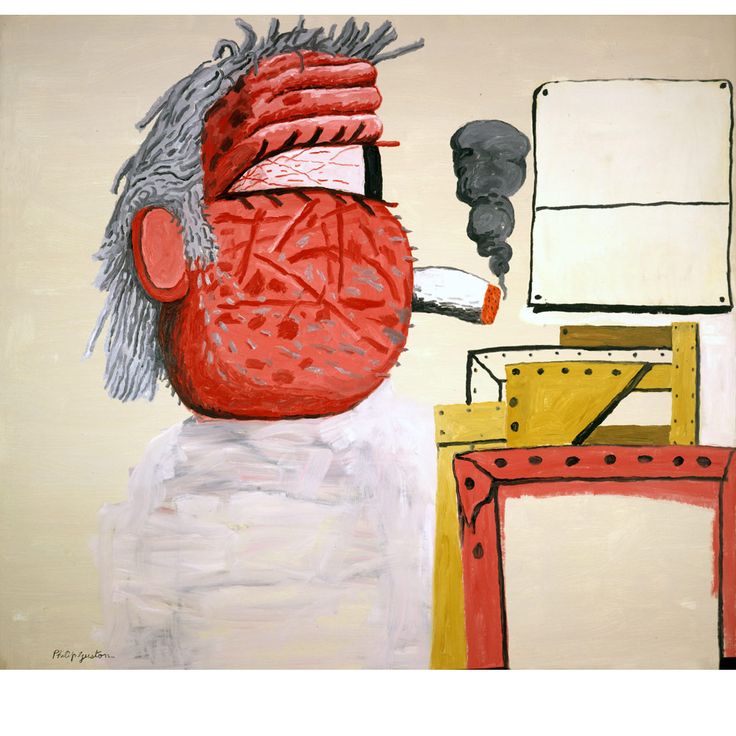 Авторами биографий Филиппа Густона в разное время являлись Муса Майер и Росс Филд.
Авторами биографий Филиппа Густона в разное время являлись Муса Майер и Росс Филд.
Творчество актуального художника Филиппа Густона, которое получило свое признание достаточно поздно, всегда отличалось удивительным и своеобразным взглядом на мир. Мир в представлении автора неизменно оставался очень мрачным местом, где людям достаточно тяжело существовать, несмотря на это взгляд автора всегда был оптимистичен и полон юмора.
Если Вам кажется, что Вы знакомы со всей живописью XX века и Вас уже ничем не удивить, то Вам определенно стоит прийти на выставку Филлипа Густона и удивиться. Необычные трансформации и переходы между абстрактной и фигуративной живописью, которые всегда сопровождались эмоциональными переживаниями и тонким чувством окружающей действительности, способны удивить любого зрителя.
Philip Guston «Untitled «(Sin título)
Художник с мультинациональными корнями, который покорил Нью-Йорк очень удачно отразил в своем творчестве различные привязанности в живописи и различные эмоциональные состояния своей жизни.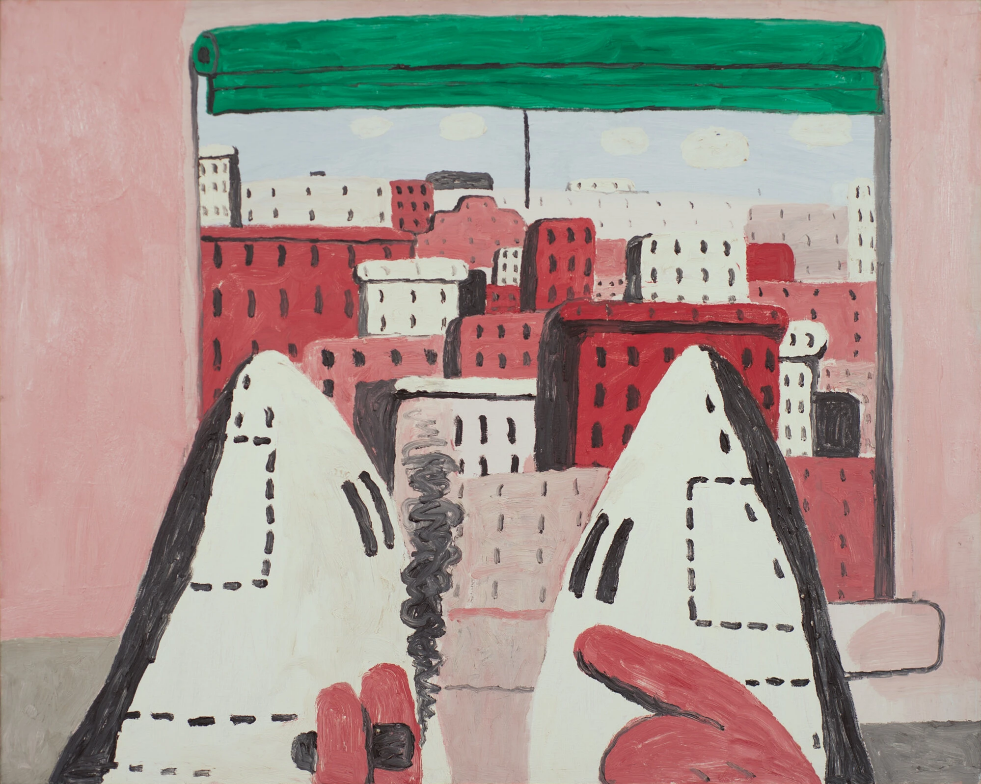
Выставка проходит в галерее Hauser & Wirth New York и будет доступна для просмотра до 30 июля 2016 года. Галерея открывает свои двери в 10AM.
Читайте Афишу — будьте в эпицентре событий!
Вас также может заинтересовать:
Густон, Филипп цитаты (35 цитат)
0 0
Густон, Филипп
Дата рождения: 27. Июнь 1913
Дата смерти: 7. Июнь 1980
Филипп Густон , наст. имя Филипп Гольдштейн — американский художник.
Фото: Sol Libsohn, [Philip Guston], 1940 Aug. 21 / Sol Libsohn, photographer. Photographic print: 1 item: b&w; 20 x 26 cm. Federal Art Project, Photographic Division collection, circa 1920-1965, bulk 1935-1942. Archives of American Art. / Public domain
Цитаты Густон, Филипп
„Man is not supposed to make life. Only God can make a tree. Why should you make a living organism? You should make images of living organisms. It seems presumptuous to attempt to make a thing which breathes and pulsates right there by itself. It’s unnatural. What’s inhuman about it is, the human way to create, I think, the way we see, from part to part. You do this and then you do that, then you do that and that. Then you learn about composition, you learn about old masters, you form certain ideas about structure. But the inhuman activity of trying to make some kind of jump or leap, where even though you naturally have to paint, after all a painting is only a painting, the painting is always saying, what do you want from me, I can only be a painting, you have to go from part to part, but you shouldn’t see yourself go from part to part, that’s the whole point That’s some kind of a leap…. I’m describing the process of painting.“
It seems presumptuous to attempt to make a thing which breathes and pulsates right there by itself. It’s unnatural. What’s inhuman about it is, the human way to create, I think, the way we see, from part to part. You do this and then you do that, then you do that and that. Then you learn about composition, you learn about old masters, you form certain ideas about structure. But the inhuman activity of trying to make some kind of jump or leap, where even though you naturally have to paint, after all a painting is only a painting, the painting is always saying, what do you want from me, I can only be a painting, you have to go from part to part, but you shouldn’t see yourself go from part to part, that’s the whole point That’s some kind of a leap…. I’m describing the process of painting.“
Help us translate this quote
— Phillip Guston
Источник: 1961 — 1980, transcript of a public forum at Boston university’, conducted by Joseph Ablow 1966, pp. 68/69
„To answer your first question — most significantly the [ Federal Art Project ] project was my training ground in the real sense of the word.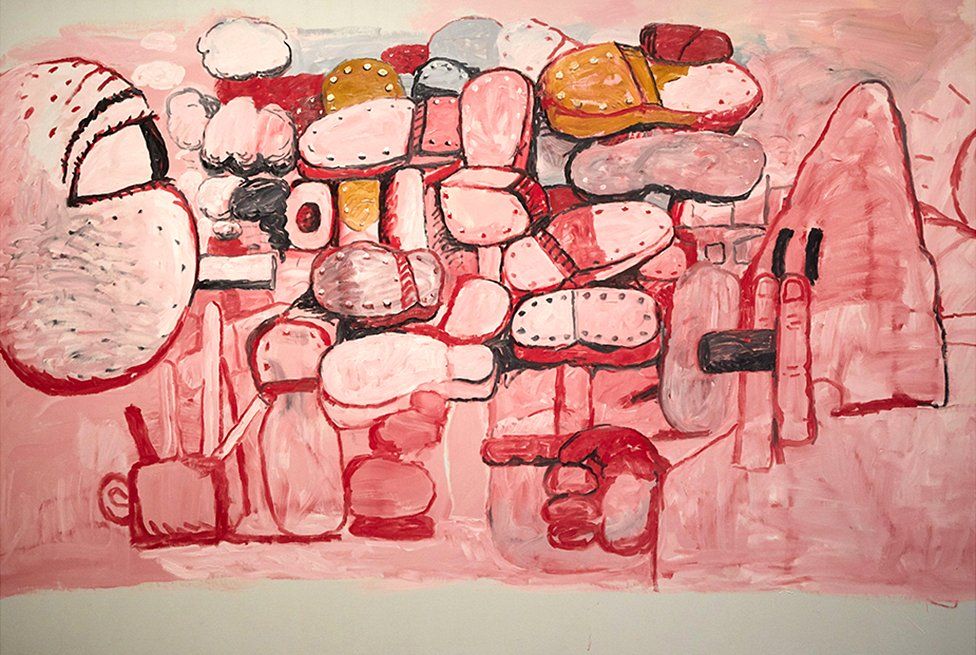 I feel very strongly about this. We were all poor, or most of us, and to have the time and opportunity to continue working — I was then in my twenties which is the important period — the crucial period for the young painter. This was most important and figures significantly in my own development. Although I feel that my personal image as a painter did not come about until I began my easel painting with personal imagery which was about 1941. The project kept me alive and working — it was my education.“
I feel very strongly about this. We were all poor, or most of us, and to have the time and opportunity to continue working — I was then in my twenties which is the important period — the crucial period for the young painter. This was most important and figures significantly in my own development. Although I feel that my personal image as a painter did not come about until I began my easel painting with personal imagery which was about 1941. The project kept me alive and working — it was my education.“
Help us translate this quote
— Phillip Guston
n.p.
1961 — 1980, Oral history interview with Philip Guston, 1965 January 29
„If you push it, it feels good; I don’t know what it is. It must have something to do with kinesthesia. I feel now that I am painting I’m not drawing anything, or even representing non-objective art. You know, you can represent abstract art, too, as well as heads figures, nudes. A lot of abstract artists are just representational painters, you know that. And a lot of figurative artists are very abstract. I don’t feel as if I’m doing that. I feel more as if I’m shaping something with my hands. I feel as if I’ve always wanted to get to that state. Like a blind man in a dark room had some clay, what would he make? I end up with 2 or 3 forms on a canvas, but it gets very physical for me. I always thought I am a very spiritual man, not interested in paint, and now I discover myself to be very physical and very involved with matter. I want to be involved with how heavy things are, a balloon, how light things are, things levitating, pushing forms, make me feel as if my hand is pushing in a head, bulges out here and pushes there.“
And a lot of figurative artists are very abstract. I don’t feel as if I’m doing that. I feel more as if I’m shaping something with my hands. I feel as if I’ve always wanted to get to that state. Like a blind man in a dark room had some clay, what would he make? I end up with 2 or 3 forms on a canvas, but it gets very physical for me. I always thought I am a very spiritual man, not interested in paint, and now I discover myself to be very physical and very involved with matter. I want to be involved with how heavy things are, a balloon, how light things are, things levitating, pushing forms, make me feel as if my hand is pushing in a head, bulges out here and pushes there.“
Help us translate this quote
— Phillip Guston
Источник: 1961 — 1980, transcript of a public forum at Boston university’, conducted by Joseph Ablow 1966, pp. 73-75
„I was forced and pushed into the kind of painting that I did [during the late 1940’s / early 1950’s]. That is to say, the demands in this dialogue with myself – I give to it, I make some marks, it speaks to me, I speak to it, we have terrible arguments going on all night, weeks and weeks – do I really believe that? I make a mark, a few strokes, I argue with myself, not do I like or not, but is it true or not? Is that what I mean, is that what I want?“
Help us translate this quote
— Phillip Guston
Источник: 1961 — 1980, transcript of a public forum at Boston university’, conducted by Joseph Ablow 1966, p. 67
67
„Lots of artists who paint have that experience to one degree or another, this release where their thinking doesn’t precede their doing. The space is shortened between thinking and doing. It’s a funny thing, what I really hate, yet I have to go through with it, is the preparation. You have to go through it, like somebody preparing for sacred vows, the sensation of you putting paint on, and it’s so boring to put paint on and to see yourself putting paint on. You’re really preparing for those few hours where some kind of umbilical cord is attached between you and it. You do it and the work is done and this cord seems to slacken, as if you left yourself there. And what a relief to leave yourself somewhere, to get out of it entirely.“
Help us translate this quote
— Phillip Guston
Источник: 1961 — 1980, transcript of a public forum at Boston university’, conducted by Joseph Ablow 1966, p. 68
„While I was still on the WPA I was submitting designs for the Section of Fine Arts competitions which I did on my own time. Burgoyne Diller gave me a mural to do in the Community Building of the Queensbridge Housing Project on Long Island. I worked on the design and cartoons for about a year. Everything was approved and the walls prepared — casein tempera painted on the wall…. [It was] about 1938. Holger Cahill asked me through Diller to do the outdoor facade mural of the WPA Building at the World’s Fair. 1 stopped work on the Queens mural and began working on the Fair mural which was finished on schedule in time for the opening of the Fair.“
Burgoyne Diller gave me a mural to do in the Community Building of the Queensbridge Housing Project on Long Island. I worked on the design and cartoons for about a year. Everything was approved and the walls prepared — casein tempera painted on the wall…. [It was] about 1938. Holger Cahill asked me through Diller to do the outdoor facade mural of the WPA Building at the World’s Fair. 1 stopped work on the Queens mural and began working on the Fair mural which was finished on schedule in time for the opening of the Fair.“
Help us translate this quote
— Phillip Guston
n.p.
1961 — 1980, Oral history interview with Philip Guston, 1965 January 29
„But you begin to feel as you go on working that unless painting proves its right to exist by being critical and self-judging, it has no reason to exist at all — or is not even possible. The canvas is a court where the artist is prosecutor, defendant, jury and judge. Art without a trial disappears at a glance.“
Help us translate this quote
— Phillip Guston
1961 — 1980, ARTnews Annual’, October 1966
„My wife [painter Musa McKim, ] on her own, did several other murals for the Section of Fine Arts. Then in 1940 and 1941 we moved out of New York City and came to Woodstock [at the age of 54] where we did the Laconia murals and several murals for the Presidents Lines, which were later turned into troop ships. I then went to teach at the University of Iowa where I finished the mural for the Social Security Building in Washington, D. C., in 1942 or 1943, I’m not sure which. With the exception of some visual aid material for the navy flight program in Iowa — navigational maps, etc.“
Then in 1940 and 1941 we moved out of New York City and came to Woodstock [at the age of 54] where we did the Laconia murals and several murals for the Presidents Lines, which were later turned into troop ships. I then went to teach at the University of Iowa where I finished the mural for the Social Security Building in Washington, D. C., in 1942 or 1943, I’m not sure which. With the exception of some visual aid material for the navy flight program in Iowa — navigational maps, etc.“
Help us translate this quote
— Phillip Guston
this marks the end of the mural period.
n.p.
1961 — 1980, Oral history interview with Philip Guston, 1965 January 29
„I went to New York in 1936 where I first worked as an assistant to Reginald Marsh as a non-relief artist since I had to await my residency requirement. This was the mural for the Customs House building in New York City. I didn’t actually paint on this mural but Marsh asked me to design some lunettes between his panels. Next I went on the WPA mural division. I worked under Burgoyne Diller who was my supervisor, he was, I think, the supervisor of the New York City mural division.“
Next I went on the WPA mural division. I worked under Burgoyne Diller who was my supervisor, he was, I think, the supervisor of the New York City mural division.“
Help us translate this quote
— Phillip Guston
n.p.
1961 — 1980, Oral history interview with Philip Guston, 1965 January 29
„To will a new form is inacceptable, because will builds distortion. Desire too, is incomplete and arbitrary. These strategies, however intimate they might become, must especially be removed to clear the way for something else – a condition somewhat unclear, but which in retrospect becomes a very precise act. This ‘thing’ is recognized only as it comes into existence. It resists analysis — and probably this is as it should be. Possibly the moral is that art cannot and should not be made.“
Help us translate this quote
— Phillip Guston
1961 — 1980, ARTnews Annual’, October 1966
„.. there comes a point when something catches on the canvas, something grips on the canvas. I don’t know what it is, you can put your paint on the surface? Most of the time it looks like paint, and who the hell wants paint on a surface? But there does come a time – you take it off, put it on, goes over here, moves over a foot, as you go closer you start moving in inches not feet, half-inches – there comes a point when the paint doesn’t feel like paint. I don’t know why. Some mysterious thing happens. I think you have all experienced it…. What counts is that the paint should really disappear, otherwise it’s craft. That’s what I mean by something grips in a canvas. The moment that happens you are then sucked into the whole thing. Like some kind of rhythm.“
I don’t know what it is, you can put your paint on the surface? Most of the time it looks like paint, and who the hell wants paint on a surface? But there does come a time – you take it off, put it on, goes over here, moves over a foot, as you go closer you start moving in inches not feet, half-inches – there comes a point when the paint doesn’t feel like paint. I don’t know why. Some mysterious thing happens. I think you have all experienced it…. What counts is that the paint should really disappear, otherwise it’s craft. That’s what I mean by something grips in a canvas. The moment that happens you are then sucked into the whole thing. Like some kind of rhythm.“
Help us translate this quote
— Phillip Guston
Источник: 1961 — 1980, transcript of a public forum at Boston university’, conducted by Joseph Ablow 1966, p. 67
„There are so many things to paint in the world – in the cities – so much to see. Does art need to represent this variety and contribute to its proliferation? Can art be that free? The difficulties begin when you understand what it is that the soul will not permit the hand to make. To paint is always to start at the beginning again, yet being unable to avoid the familiar arguments about what you see yourself painting. The canvas you are working on modifies the previous ones in an unending, baffling chain which never seems to finish.“
To paint is always to start at the beginning again, yet being unable to avoid the familiar arguments about what you see yourself painting. The canvas you are working on modifies the previous ones in an unending, baffling chain which never seems to finish.“
Help us translate this quote
— Phillip Guston
What sympathy is demanded of the viewer! He is asked to ‘see’ the future links
1961 — 1980, ARTnews Annual’, October 1966
„You use things; the idea is, of course, to eliminate things [in making a picture]. And just as fifteen or eighteen years ago [when Guston made whole figurative series of children’s pictures: ‘all sort of props and so on’] I stretched out to get that, — put it in and took it out — to get that look in that’s kid’s eye and the way his mouth was open or wasn’t — I mean a very particular kind of look — I’d do the same now. In other words, I can’t find any freedom in abstract painting [but Guston did abstract painting in 1960 — till in 1967 he moved to figuration]. I’am just as stuck with locations, a few areas of colour in relation to some kind of totality that I want, as I was before. And so the problem of figuration is somehow irrelevant to me. I think some of the best painting done in New York today is figuration, but it’s not recognised as such… Well I think of my pictures as a kind of figuration… I think every good painter here in New York really paints a self-portrait..“
I’am just as stuck with locations, a few areas of colour in relation to some kind of totality that I want, as I was before. And so the problem of figuration is somehow irrelevant to me. I think some of the best painting done in New York today is figuration, but it’s not recognised as such… Well I think of my pictures as a kind of figuration… I think every good painter here in New York really paints a self-portrait..“
Help us translate this quote
— Phillip Guston
Источник: 1950 — 1960, Interview with David Sylvester, BBC (March 1960), pp. 92-93
„There is something ridiculous and miserly in the myth we inherit from abstract art: That painting is autonomous, pure and for itself, and therefore we habitually analyze its ingredients and define its limits. But painting is ‘impure’. It is the adjustment of ‘impurities’, which forces painting’s continuity. We are image-makers and image-ridden. There are no ‘wiggly or straight lines’ or any other elements. You work until you vanish. The picture isn’t finished if they are seen.“
The picture isn’t finished if they are seen.“
Help us translate this quote
— Phillip Guston
transcript of the panel, March 1960, held at the Philadelphia Museum School of Art, as quoted in Abstract Expressionism Creators and Critics, edited by Clifford Ross, Abrams Publishers New York 1990, p.61
1950 — 1960
„Actually, one of the real problems that always bothers me [in creating a painting] is sustaining a feeling. I mean, when I look at Poussin now, well, I think that’s the most incredible thing to maintain the feeling for a year, however long it took Poussin, I’m telling you, to paint this vast structure. Bur perhaps that is not given to us now. I don’t know…. Actually all all modern art puzzles me. I don’t understand it. II really don’t. I don’t know whether it is fragmentary [as David Sylvester the interviewer suggested]. I have a sickening nostalgia for this other state of sustaining a feeling for months, being able to construct and build a picture. Well Mondrian, I think, did that, of course.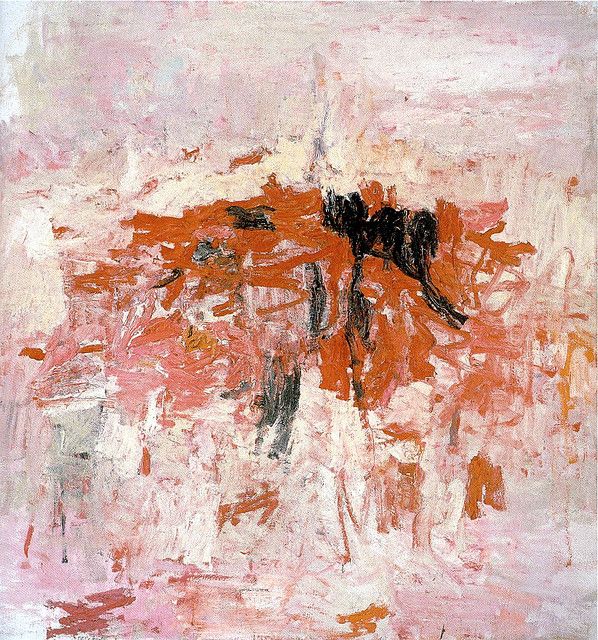 He was almost one of the last artists to do that. I wish I could get there.“
He was almost one of the last artists to do that. I wish I could get there.“
Help us translate this quote
— Phillip Guston
Источник: 1950 — 1960, Interview with David Sylvester, BBC (March 1960), pp. 91-92
„[On the question: ‘What was your main stylistic influence up to this time’]: The Renaissance chiefly — Piero, Mantegna, Uccello — but I was attracted also by the modern idioms — Léger, Picasso — and was close to the abstract painters on the project such as Stuart Davis, Burgoyne Diller, Arshile Gorky, Balcomb Greene, etc. At the time I did the Queens project, there was already a marked change in my work — it was becoming more concerned with cubist concepts of treating space.“
Help us translate this quote
— Phillip Guston
n.p.
1961 — 1980, Oral history interview with Philip Guston, 1965 January 29
„What is seen and called the picture is what remains – an evidence. Even as one travels in painting towards a state of ‘unfreedom’ where only certain things can happen, unaccountably the unknown and free must appear.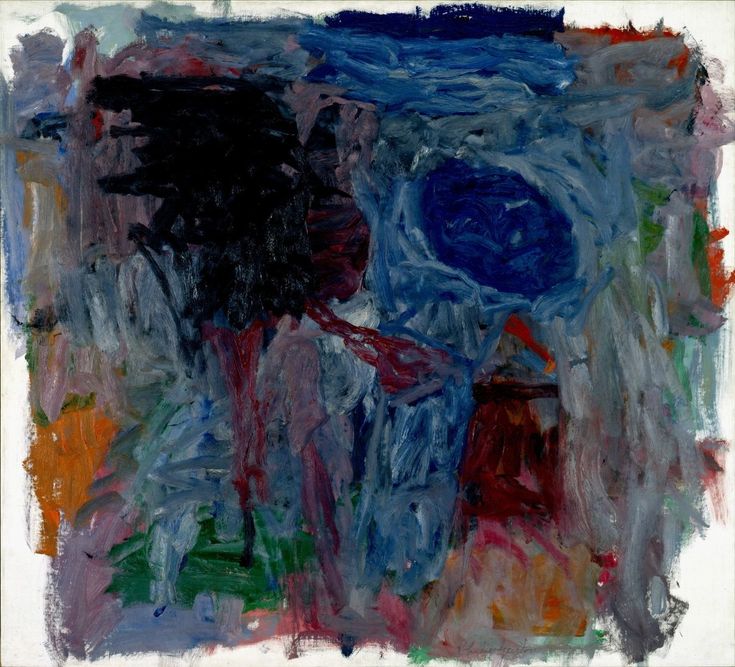 Usually I am on a work for a long stretch, until a moment arrives when the air of the arbitrary vanished and the paint falls into positions that feel destined. The very matter of painting – its pigment and space – is so resistant to the will, so disinclined to assert its plane and remain still. Painting seems like impossibility, with only a sign now and then of its own light. Which must be because of the narrow passage from a diagramming to that other state – corporeality. In this sense, to paint is a possessing rather than a picturing.“
Usually I am on a work for a long stretch, until a moment arrives when the air of the arbitrary vanished and the paint falls into positions that feel destined. The very matter of painting – its pigment and space – is so resistant to the will, so disinclined to assert its plane and remain still. Painting seems like impossibility, with only a sign now and then of its own light. Which must be because of the narrow passage from a diagramming to that other state – corporeality. In this sense, to paint is a possessing rather than a picturing.“
Help us translate this quote
— Phillip Guston
12 Americans, by Dorothy C.Miller, New York, 1956. p. 36
1950 — 1960
„.. when I see people making quote ‘abstract’ painting, I think it’s just a dialogue and a dialogue isn’t enough, that is to say, there is you painting and this canvas. I think there has to be a third thing, it has to be a trialogue. Whether that third thing — it must be, to reverberate and make trouble, you have to have trouble and contradictions, it has to become complex because life is complex, emotions are complex, — whether that third element is a still life of something, or an idea or a concept, in each case it has to be a trialogue and above all has to involve you.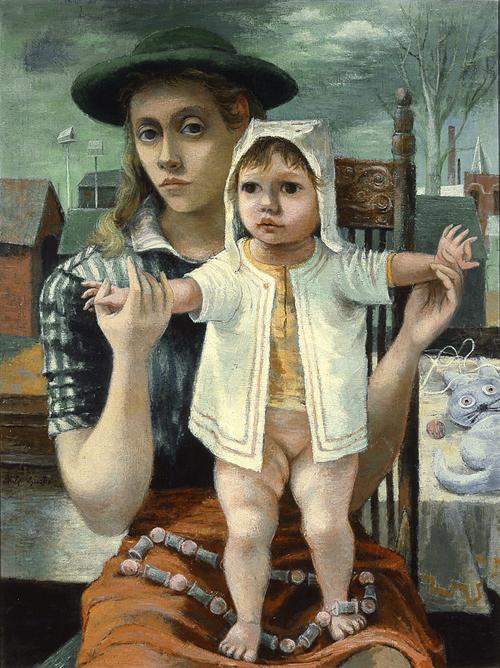 … The real thing that matters is how involved you are in that.“
… The real thing that matters is how involved you are in that.“
Help us translate this quote
— Phillip Guston
Источник: 1961 — 1980, transcript of a public forum at Boston university’, conducted by Joseph Ablow 1966, pp. 73-75
„I have a studio in the country — in the woods – but my paintings look more real to me than what is outdoors. You walk outside; the rocks are inert, even the clouds are inert. It makes me feel a little better. But I do have a faith that it is possible if you can move that inch.“
Help us translate this quote
— Phillip Guston
1961 — 1980, ARTnews Annual’, October 1966
„I should like to paint like an man who has never seen a painting, but this man – myself – lives in a museum.“
Help us translate this quote
— Phillip Guston
Abstract Expressionism, David Anfam, Thames and Hudson Ltd London, 1990, p. 207
1961 — 1980
Подобные авторы
Филип Гастон
Музей американского искусства Уитни, покупка на средства Hearst Corporation и Norman and Rosita Winston Foundation, Inc. 2 (Искья) , 1949
2 (Искья) , 1949
Тренажер для накачивания одежды (для предполетной подготовки ВМС) , 1943
Через , 1967
5
5 Побережье Мексиканского залива 6 , 1943
0005 Untitled , 1967
Staatliche Graphische Sammlung München, Sammlung Udo und Anette Brandhorst
Untitled (книга) , 1967
Window , 1969-1970
The Moder at Moder Art Art Art, New wish
, 1969-1970
9000. Без названия , 1980
Обещанный подарок Музею Метрополитен от Мусы Гастона Майера
Мать и дитя , 1930
Региональный музей Мичоакано, Морелия, Мексика
Борьба с войной и фашизмом , 1935
Художественный музей Филадельфии, Дар Музы и Тома Майеров, 2011
Бомбардировка , 1938
Музей современного искусства, Нью-Йорк. Дар Эдварда Р. Бройды
Гладиаторы , 1940
Художественный музей Сент-Луиса, Eliza McMillan Trust, 115:1942
Боевая память , 1941
000003 Музея искусства ГустонераАвтопортрет , 1944
Художественный музей Милдред Лейн Кемпер, Вашингтонский университет в Сент-Луисе. Покупка университета, Kende Sale Fund, 1945
Покупка университета, Kende Sale Fund, 1945
If This Be Not I , 1945
Munson-Williams-Proctor Arts Institute Museum of Art, Utica, New York, Museum Purchase
The Porch II6 , 1947 9000 Коллекция SFMOMA, Дар художника
Мучители , 1947
Коллекция SFMOMA, T. B. Walker Foundation Покупка в фонд
Белая живопись I , 1951
Частная коллекция, Нью -Йорк
Зона , 1953
Коллекция Уокера Художественный центр, Миннеаполис, подарок Джуди и Кеннет Дейтон, 2022
, 1953
. Коллекция
Радости нищего , 1954-55
Художественный музей Милдред Лейн Кемпер, Вашингтонский университет в Сент-Луисе. Покупка университета, Фонд Биксби, 1957
Fable , 1956
Коллекция Неизвестно
Феллини , 1958
Высокий музей искусств, Атланта, покупка на средства Национального фонда искусств
Художник , 1959
Коллекция Гарри Андерсона, Стэнфордский университет 9000 и Мэри Маргарет Андерсон, и Мэри Патрисия Андерсон Пенс, 2014.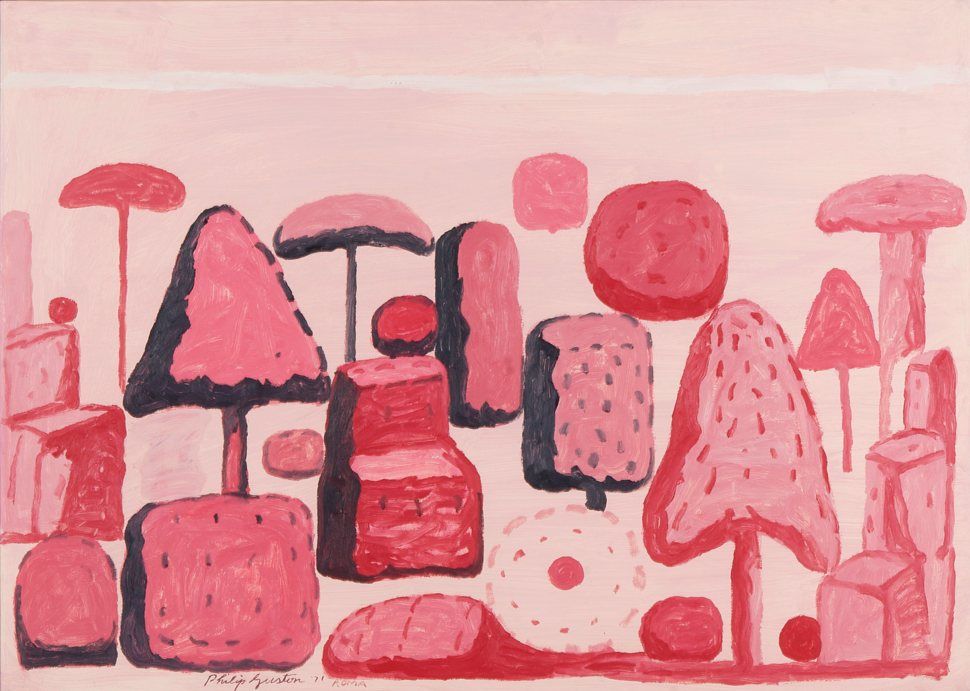 1.046
1.046
The Tale , 1961
Частная коллекция
Группа II , 1964
Частная коллекция-Блумс, Мичиган0003
мая шестьдесят пять , 1965
Обещанный подарок музы Густон Майер в Метрополитен Музей искусств
Пау , 1968
Частная коллекция
Бесполевые , 1968
Проданный подарок Mussa Guston MySa Guston Musa Guston Musa Guston Musa Guston guston. Метрополитен-музею
Tall Book , 1968
Обещанный подарок Мусы Густона Майера Метрополитен-музею
Без названия , 1968
Музей искусств Метрополитен Музею Гус9 Обещанный подарок Мусе Густонеру
Untitled(Picture) , 1968-1973
Обещанный подарок Музею Метрополитен от Musa Guston Mayer
The Studio , 1969
The Guston Foundation
City , 1969
Коллекция SFMOMA, подарок Байрона Р. Мейер
КАРТАННЫ0003 Farnesina Garden Rome , 1971 частная коллекция без названия , 1971 Обещанный подарок Мусы Густон Майер в Метрополитный музей искусства Безподобный (ROME) , 1971 . Alone , 1971 Национальная художественная галерея, Вашингтон, округ Колумбия, подарок (частичный и обещанный) посла и миссис Дональд М. Блинкен в память о Морисе Х. Блинкене и в Честь 50-летия Национальной галереи искусств Стол художника , 1973 Обещанный подарок Мусы Гастона Майера Метрополитен-музею Палитра , 1975 Музей современного искусства, Нью-Йорк. Дар Эдварда Р. Бройды Веб , 1975 Частная коллекция, Германия Магнит , 1975 Музей современного искусства, Нью-Йорк. Подарок Эдварда Р. Бройды в честь дяди Сидни Фельдмана Источник , 1976 Тейт, Лондон, приобретено при содействии Американского фонда для галереи Тейт 1991 Памятник , 1976 Музей и сад скульптур Хиршхорна, Смитсоновский институт, Вашингтон, округ Колумбия, Программа приобретения коллекций Риджентс, 00037 Древняя стена , 1976 Национальная галерея Австралии, Канберра, куплена в 1980 г. Яма , 1976 г. 11 The Painter , 1976 Коллекция SFMOMA, Дар художника Вид сзади , 1977 Собрание Музея современного искусства Форт-Уэрта, Приобретение музеем, The Friends of Art Endowment Fund Форма II 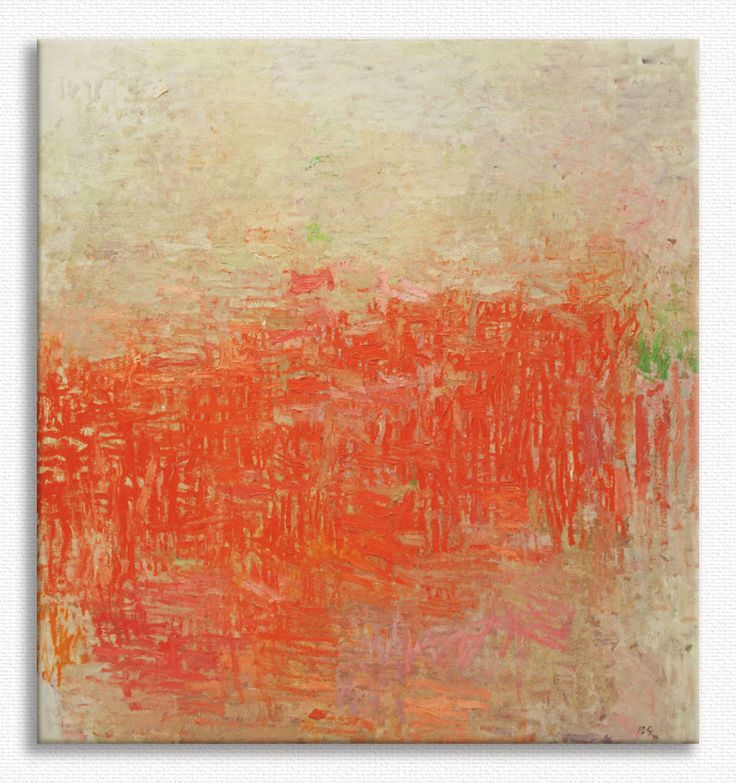 Поданный в Malsa of Musa of Musa of Musa of Musa of Musa of Musa of Musa of Musa of Musaed Гастона Майера в Метрополитен-музей
Поданный в Malsa of Musa of Musa of Musa of Musa of Musa of Musa of Musa of Musa of Musaed Гастона Майера в Метрополитен-музей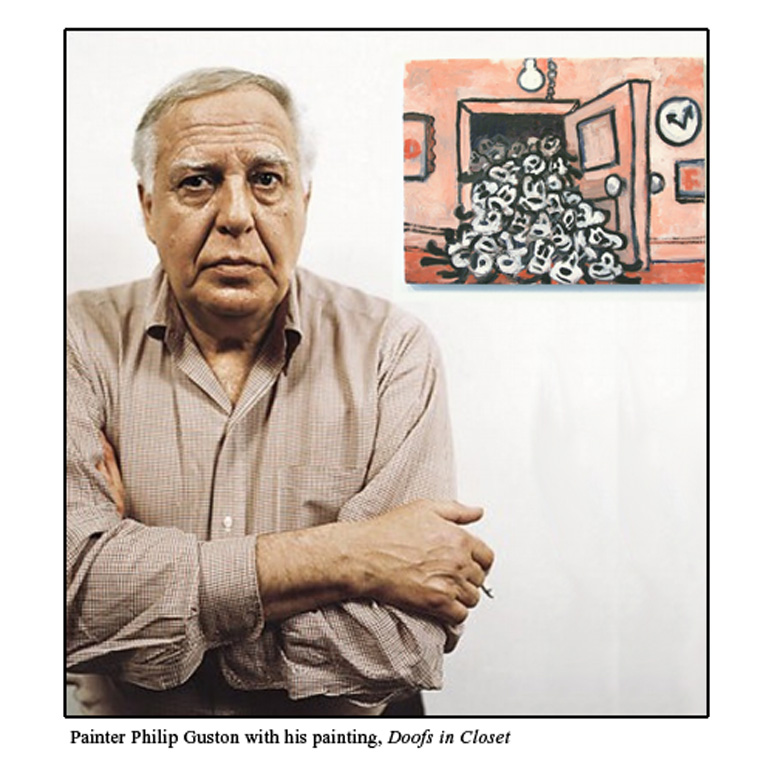
Музей современного искусства, Нью-Йорк. Дар Эдварда Р. Бройды
Talking , 1979
Обещанный подарок Мусы Гастона Майера музею Метрополитен
Untitled , 1980
Philip Guston
Обещанный подарок Муса Густона Майера в Метрополитен Музей искусств
Обнаженный философ в космосе, 1935
Private
. Sunday Sunday, 1935
7413935
6 19419191919191919
.Обещанный подарок Мусы Гастона Майера Метрополитен-музею
Муса МакКим , 1942
Обещанный подарок Мусы Гастона Майера Метрополитен-музею
Святилище , 1944
Художественный музей Стэнли Университета Айовы, дар доктора Кларенса Ван Эппса, 1947. 24
24
Молодая мать, 1944
Krannert University of Xaminigna, Художественный музей Ихаминпавилино, Палион . Фонд закупок фестиваля искусств 1948-10-1
The Porch , 1946
Обещанный подарок Мусы Гастона Майера Метрополитен-музею
Церемония, 1946
Музей Артура Хоппока, Музей Метрополитен Фонда, 1950
исполнителей , 1947
Национальная галерея искусств, Вашингтон, Bequest of Musa Guston, 1992.86.2
Обзор , 1948-49
Смитсоновский американский музей искусства, музей покупка
. , 1951
Художественный музей Сиэтла, Дар Фонда Пятницы в честь Ричарда Э. Ланга и Джейн Лэнг Дэвис, 14.10.2020
B.W.T., 1952
Музей Метрополитен, Дар миссис Лоуренс Софиан, 19 лет90
#5 , 1952
Музей современного искусства, Нью-Йорк. Филипп Джонсон Фонд
Живопись , 1954
Коллекция SFMOMA, Anonymous Gift, Los Angeles
для M. , 1955
, 1955
Музей американского искусства Уитни, покупка
Dial , 1956 Коллекция Phillips Collect , Вашингтон, округ Колумбия, Приобретено в 1958 г. Возвращение туземцев , 1957 г. Художественный музей округа Лос-Анджелес, Майкл и Дороти Бланкфорт Завещание, AC1999.35.24. фото © Museum Associates/LACMA Hester , 1957 Художественный музей Кливленда, Современная коллекция Кливлендского художественного музея 1961.21 Sleeper , 1958 Инге. Фото: Тиффани Мэтсон Canal , 1958 Музей изящных искусств Монтгомери, Монтгомери, Алабама, подарок Элджи Хилл Нилл в память о ее муже, Джоне Х. Нилле-младшем Road , 1959 Музей современного искусства Луизианы, приобретен при финансовой поддержке The C.L. Фонд и коллекция Дэвида Зеркало — С.К. , 1960 Художественный музей Балтимора, фонд закупок Стол , 1960 Музей искусств Стэнли Университета Айовы, приобретенный с помощью средств Национального фонда искусств и соответствующего пожертвования г-жи Орал Себелин, 1973. Край , 1960 Музей Соломона Р. Гуггенхайма, Нью-Йорк Duo , 1961 Kunstmuseum Winterthur, Приобретено на средства лотерейного фонда кантона Цюрих 1993, инв. нет. Двое Dark Form , 1963 Коллекция Музея современного искусства Форт-Уэрта, покупка музеем, Благотворительный фонд друзей искусства The Light , 1964 Мемориальный художественный музей Аллена, Оберлин-колледж, Огайо; Завещание Мусы Гастона Air I , 1965 Художественный институт Чикаго, Анонимный подарок Портрет II , 1965 Мемориальный художественный музей Аллена, Оберлин-Колледж, Огайо; Завещание Мусы Густона Untitled , 1968 Обещанный подарок Муса Густона Майера в Метрополитен Музей искусств Без названия , 1968 Обещанный подарок Мусы -Густон Майер 29
29

Гарвардские художественные музеи/музей Фогга, завещание Мусы Гастона. Фото: Департамент обработки изображений © Президент и члены Гарвардского колледжа
Без названия , 1968
Обещанный подарок Мусы Гастона Майера Метрополитен-музею
Untitled (City) , 1968
Promised gift of Musa Guston Mayer to The Metropolitan Museum of Art
Untitled , 1968
Promised gift of Musa Guston Mayer to The Metropolitan Museum of Art
Untitled ( Голова и стена) , 1969
Музей современного искусства, Нью-Йорк. Дар Мусы Гастона
City Limits , 1969
Художественный музей Кливленда, подарок к семьдесят пятой годовщине Агнес Гунд, 19 лет91.28
Tour, 1969
Художественный музей Портленда, Портленд, Орегон. Завещание Мусы Гастона
Без названия, 1969
Галерея Хью Лейна, подаренная семьей Конлон в соответствии с разделом 1003 Закона о консолидации налогов, 2005 г. , Рег. № 1985
, Рег. № 1985
Окраина, 1969
Калифорнийский университет, Художественный музей Беркли и Тихоокеанский киноархив; Дар миссис Филип Гастон и Мусы Джейн Майер
Central Avenue, 1969
Гиршхорн Музей и сад скульптур, Смитсоновский институт, Вашингтон, округ Колумбия, Завещание Муса Густона, 1992
Без названия, 1971
Дейтонский художественный институт, Bequest of Musa Guston, 1992.15 1971 Частная коллекция Без названия , 1971 Обещанный подарок Мусы Густона Майера Метрополитен-музею Римский сад , 19730002 Художественный музей Фралина в Университете Вирджинии, завещание Мусы Гастона, 1992.14. фотография Лии Стернс
Без названия (Книги и окно), 1971
Обещанный подарок Мусы Гастона Майера Музею искусств Метрополитен
Мать и дитя , около 1930 г.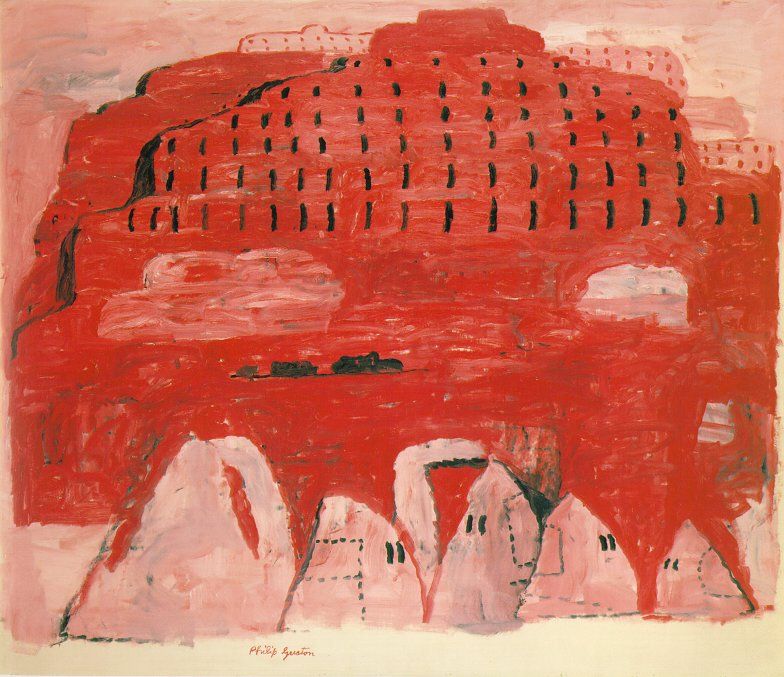 щедрая поддержка Vereniging Rembrandt and Mrs. Musa Guston, Woodstock, NY, 1983
щедрая поддержка Vereniging Rembrandt and Mrs. Musa Guston, Woodstock, NY, 1983
Живопись, Курение, Еда, 1973
Обетованный подарок Муса Густона Майера в Метрополитенский музей искусств
Курение I , 1973
Обещанный подарок Муса Густона Майера в Метрополитный музей искусств
Pantheon , 1973
Antlish
, 1973
.
Язык I , 1973
Художественный музей Худа, Дартмутский колледж: завещание Мусы Густона Роберт Шенберг, по обмену 8:1990
Аллегория, 1975
Художественный музей Далласа, наследие Мусы Гастона
Розовое лето, 1975
Музей современного искусства, Нью-Йорк. Дар Эдварда Р. Бройды
Web , 1975
Музей современного искусства, Нью-Йорк. Дар Эдварда Р. Бройды
Потоп II, 1975
Коллекция Центр искусств Уокера, Миннеаполис, Завещание Мусы Гастона, 1992
Бомбей, 1976
Художественный музей Гонолулу, Bequest of Musa Guston, 1992 (7008,1)
вишня III, 1976
Национальная галерея Канады, купленная 1999
, 1976
Музей Whitney.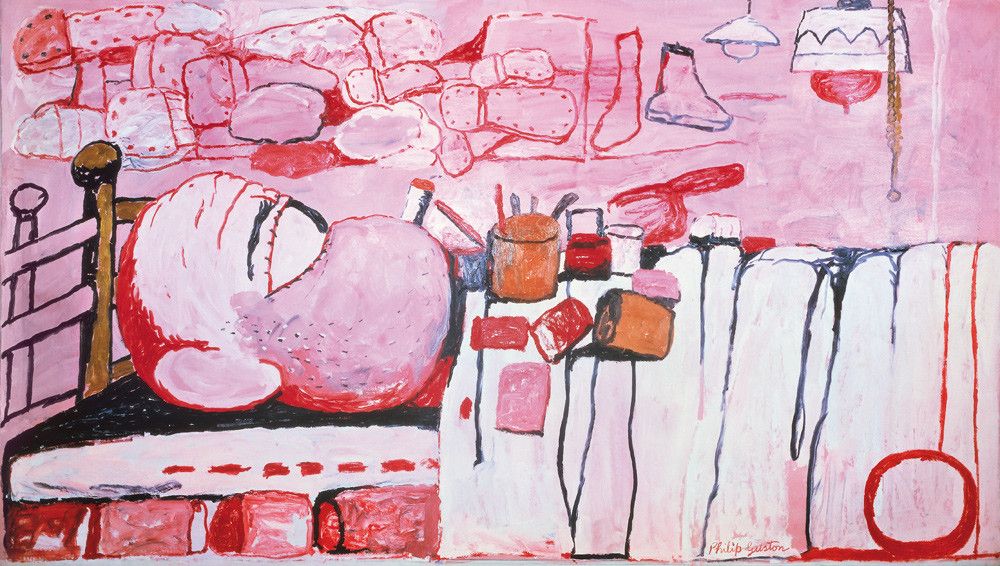 Подарок к 50-летию мистера и миссис Рэймонд Дж. Лирси
Подарок к 50-летию мистера и миссис Рэймонд Дж. Лирси
Кабал, 1977
Бруклинский музей, завещание Мусы Гастона
Красная ткань, 1976
Национальный фонд искусств и Фонд Брауна
Океан, 1976
Художественный институт Чикаго, по предварительному завещанию Фрэнсис В. Пик и памятный подарок от ее дочери Мэри П. Хайнс
Пара в постели, 1977
Музей изящных искусств Искусство, Хьюстон, приобретение музеем, финансируемое Фондом музея Элис Пратт Браун
Legend, 1977
Художественный музей Сиэтла, наследие Мусы Гастона
The Fable, 1977
Национальная художественная галерея, Вашингтон, Дар Эдвард Р. Бройда, 2005.142.17
Лестница , 1978
Музей современного искусства, Нью-Йорк. Приобретено через фонды А. Конгера Гудьира и Элизабет Блисс Паркинсон и дар художника.
Могила , 1978
Художественный музей Кливленда, завещание Мусы Гастона 1992.
